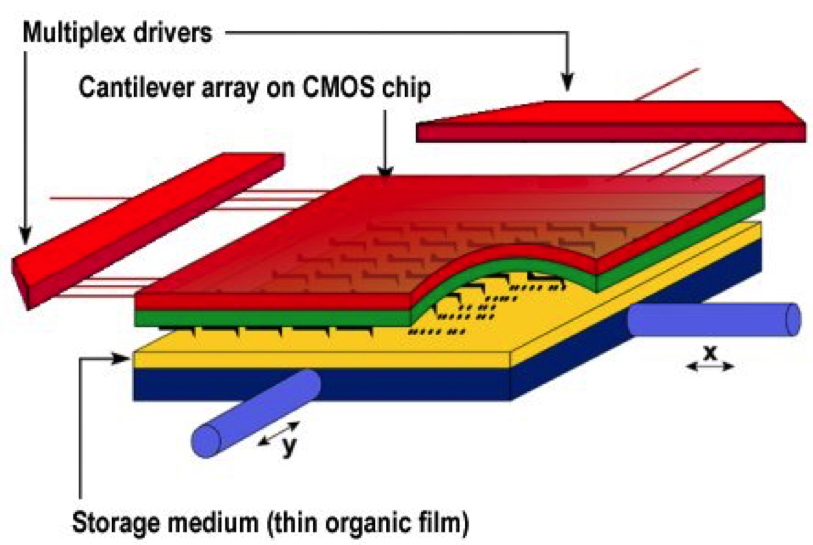History 2005: At CeBIT, IBM Reveals Revolutionary Storage Technology
Millipede
By Jean Jacques Maleval | August 26, 2024 at 2:01 pmCeBIT 2004, seemingly lost in a free-fall, was particularly disappointing. Fear not, the 2005 edition was much more promising. And one product rose from the ashes: IBM’s Millipede.

IBM’s Millipede is not based on any storage technologies known before now, be they magnetic, optical or flash, or even holography, FRAM or MRAM, the impending greatness of which we’ve been hearing about for so long now, we’re beginning to wonder. We could liken it to flash technology, since it is exclusively chip-based, but in fact, it isn’t at all the same thing. It is essentially mechanical, based on MEMS (Micro Electro Mechanical Systems), micro-motors on chip.
“We are now at 1Tb per square inch“, said Dr. Christoph Hagleitner, working at the IBM Zurich Research Laboratory, on a project whose beginnings date back to 1996.
It’s the equivalent of nearly 100GB on a surface area the size of a postage stamp. Which means it has nearly 10x the areal density of the best HDDs currently available.
Why do we think Millipede, developed by scientists in the Zurich lab, stands a better chance of reaching the market than every other storage technology not based on magnetic and optical media that never gets past the research stage?
For at least two reasons:
- IBM officially introduced it at CeBIT as a “technology product,” showing a prototype with a video-microscope offering a look inside the storage unit. Recall, though, that IBM’s first 1.8-inch disk drive was shown for the first time at CeBIT’92 and was eventually realized. Similarly, the company showed a prototype of a 1TB magnetic tape cartridge last year. And you can bet it will happen.
- Somewhat related to the previous reason, it is Big Blue we’re talking about that’s backing the project, and not one of the many start-ups that scratch away with limited means hoping to revolutionize the storage industry.
In addition to its extremely high capacity, the Millipede’s overall performance is also quite impressive: “An access time comparable to flash, i.e. a few milliseconds, a transfer rate greater than 20Mb/s, and at least 100,000 cycles of overwriting like flash,” according to Hagleitner.
He sees the Millipede more likely o competing against tiny disk drives than with the flash memory used in mobile phones and digital cameras. It therefore doesn’t seem as though the new technology will be mobilized to take on the high capacities of desktop, enterprise or even notebook units, no doubt due to its price, which is “competitive with flash.”
The prototype we saw was outfitted with a SmartDisk form-factor. It remains to be seen whether IBM will decide to forge ahead with this new technology, which requires major investment, in particular for the MEMs manufacturing.
Hagleitner said that the technology will be ready to appear on the market in 2 or 3 years. We’ll see.
This article is an abstract of news published on issue 207 on April 2005 from the former paper version of Computer Data Storage Newsletter.
Note: Millipede never happens on the market.














 Subscribe to our free daily newsletter
Subscribe to our free daily newsletter

